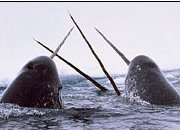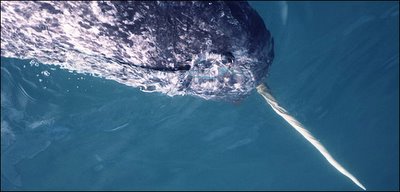Three Way News
Your Source. For everything. Really.
Contributors
- Hammer
- Jambo
- Libby Mae
Current Poll
Recurring features
Hammer's Favorites
- Dobson v. Sponge-Bob
- Calvin, the nest egg
- Pat's predictions
- Bachmann spins Cupertino
- 205 atheists assume the bench
- Fox spins Oil for Food
- Fact check: highest taxed state
- Gen. Myers v. Reality
- Janice Rogers Brown
- Killing Field
- Kline hates Big Bird
- Vote Luca Brasi!
- Cornyn's Stalinist Supreme Court
- Rumsfeld's hidden metrics
Jambo's Favories
- Dolphin research updates
- We all shine on
- If you have to write...
- Columnist NY Times should have
- Truth about taxes
- Fourth of July
- Movie objects
- Lost in supermarket
- Dysfunctional Farmer Labor party
- Punks you hated
- Some preacher from east
- Winning issues

Monday, December 12, 2005
One big tooth
Tuesday's NYT has a very interesting, to me at least, article on a new theory about the narwhal. One of the science highlights of my life was getting a backstage tour at the Smithsonian Museum of Natural History conducted, as it turns out, by one of the people quoted in the article. He showed a friend and me the entire marine mammal collection with everything from porpoise and orca skulls to whale vertebrae the size of manhole covers. But the best part was getting to pick up a seven foot narwhal tusk. For a biology geek that's right up there with a trip to the Galapagos. I suppose it would be like an ID proponent finding a divine oil spot on his driveway in the shape of a caveman riding a dinosaur. (Let the pilgrimage begin!) OK, to be fair, the narwhal tusk was the second best part. The best part was showing up my friend, a masters student at the time and working in the department, by correctly identifying a sperm whale skull and then going all Socratic on her when she couldn't do the same. "Oh come on, look at that lower jaw! What do you THINK it is?" She finished her masters and does still talk to me but I don't think she has ever quite forgiven me. In any case, long story short: narwhals are cool.
For centuries, the tusk of the narwhal has fascinated and baffled.
Narwhal tusks, up to nine feet long, were sold as unicorn horns in ages past, often for many times their weight in gold since they were said to possess magic powers. In the 16th century, Queen Elizabeth received a tusk valued at £10,000 - the cost of a castle. Austrian lore holds that Kaiser Karl the Fifth paid off a large national debt with two tusks. In Vienna, the Hapsburgs had one made into a scepter heavy with diamonds, rubies, sapphires and emeralds.
Scientists have long tried to explain why a stocky whale that lives in arctic waters, feeding on cod and other creatures that flourish amid the pack ice, should wield such a long tusk. The theories about how the narwhal uses the tusk have included breaking ice, spearing fish, piercing ships, transmitting sound, shedding excess body heat, poking the seabed for food, wooing females, defending baby narwhals and establishing dominance in social hierarchies.
But a team of scientists from Harvard and the National Institute of Standards and Technology has now made a startling discovery: the tusk, it turns out, forms a sensory organ of exceptional size and sensitivity, making the living appendage one of the planet's most remarkable, and one that in some ways outdoes its own mythology.
...
The scientists say the nerves can detect subtle changes of temperature, pressure, particle gradients and probably much else, giving the animal unique insights. ...
James G. Mead, curator of marine mammals at the Smithsonian Institution in Washington, where Dr. Nweeia is a research associate, said the exposed nerve endings appear to be unparalleled in nature.
"As far as I can see, it's a unique thing," Dr. Mead said in an interview. "It's something new. It just goes to show just how little we know about whales and dolphins."

4 Comments:
I thought we all had a 9' long sensory organ of exceptional size and sensitivity, making the living appendage one of the planet's most remarkable, and one that in some ways outdoes its own mythology.
By , at 11:35 AM
Well put.
I wondered how long it would take for that angle to show up.
47 mins., but who's counting?
By , at 8:55 AM
<< Home



